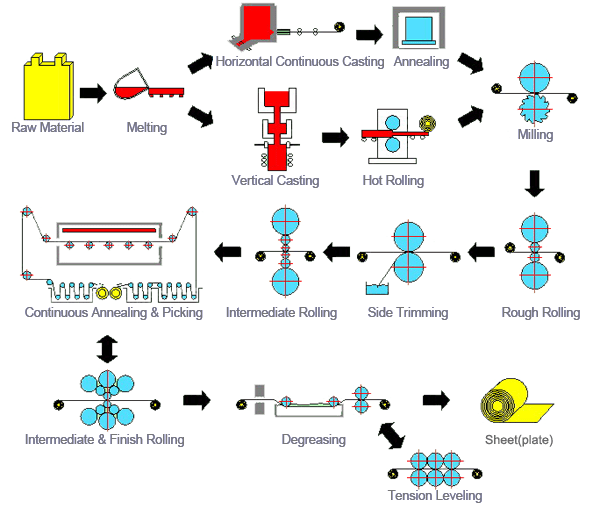In this article, we would discuss the most modern procedure used by various steel mills across the globe to produce steel, and further processing the same to steel plates, sheet and coils.
The Steel Plates Manufacturing Process…
Primary Steel Making
Steelmaking starts with melting the raw inputs of iron ore, coke (produced by carbonisation of coking coal) and limestone together in a blast furnace. The resulting red hot molten iron contains 4-4.5% carbon and other impurities that make it brittle. So we need to move to further process the steel to achieve the desired quality. Primary Steel is produced by two methods –
- Basic Oxygen Furnace (BF) – When the starting input material is iron ore, then the steel plant is generally called the integrated steel plant. In this case, firstly hot metal or liquid pig iron is produced in a vertical shaft furnace called the blast furnace (BF). In this process recycled scrap steel is also added to the molten iron in a converter. Coke serves two purposes in the BF – Firstly it provides heat energy on combustion and secondly carbon for reduction of iron ore into iron. Limestone on decomposition at higher temperature provides lime, which combines with silica present in the iron ore to form slag. It also combines with sulphur in the coke and reduces its content in the liquid pig iron or hot metal collected at the bottom of the BF. At high temperatures, oxygen is blown through the metal, which reduces the carbon content and oxidises the impurities like silicon, manganese, and phosphorus. Lime is charged to slag off the oxidised impurities.
- Electric Arc Furnace (EAF) – In the EAF process, recycled steel scrap is added through use high-power electric arcs (temperatures up to 1650 C) to melt the metal and convert it into high-quality steel.
Secondary Steel Making
Steel produced by the above two methods is further treated to adjust the steel composition, by adding or removing certain elements and managing the temperature and production environment.
Liquid steel is cast into ingots, which after soaking at 1280-1300 oC in the soaking pits are rolled in the blooming and billet mill into blooms/billets or in slabbing mill into slabs. The continuous cast product is cut into desired lengths, based on the final product application: such as slabs for flat products (plate and strip), blooms for sections (beams), billets for long products (wires) or thin strips.
Manufacturing Hot Rolled Steel Plates – Mild Steel & Carbon Steel Plates
The slabs after heating to similar temperature are rolled into plates in the plate mill. Even though the chemical composition of steel dictates the mechanical properties, its final mechanical properties are strongly influenced by rolling practice, finishing temperature, and cooling rate and subsequent heat treatment. The process of hot rolling helps to remove the surface defects and helps to achieve the desired shape and quality. In a manufacturing process, steel plates are annealed to make them less brittle. Generally plates or coils can be hot rolled upto 3mm and even 2.5mm thickness sometimes. If thickness below 2.5mm is required, generally coil and sheets are cold rolled to achieve the desired quality, size and thickness. Mild and carbon steel plates are produced by mill process which involves rolling the steel at a high temperature (typically at a temperature over 1700° F), which is above the steel’s recrystallization temperature. When steel is above the recrystallization temperature, it can be shaped and formed easily, and the steel can be made in much larger sizes. Hot rolled steel is typically cheaper than cold rolled steel due to the fact that it is often manufactured without any delays in the process, and therefore the reheating of the steel is not required (as it is with cold rolled). When the steel cools off it will shrink slightly thus giving less control on the size and shape of the finished product when compared to cold rolled. Hot rolling of steel plates improves: Toughness and strength, Ductility, Resistance to vibration and shock, Formability and Weldability.
Manufacturing Cold Rolled Steel Sheets/Coils
Cold rolling is a metal working process in which metal is deformed by passing it through rollers at a temperature below its recrystallization temperature. Cold rolling increases the yield strength and hardness of a metal by introducing defects into the metal’s crystal structure. These defects prevent further slip and can reduce the grain size of the metal, resulting in Hall-Petch hardening. Cold rolled steel is essentially hot rolled steel that has had further processing. The steel is processed further in cold reduction mills, where the material is cooled (at room temperature) followed by annealing and/or tempers rolling. The cold rolled process creates a finished product that is more precise dimensionally than a hot rolled product. This is because it is already closer to the finished dimension since it has already gone through the cooling process.
Uses: Any project where tolerances, surface condition, concentricity, and straightness are the major factors.
The Author – Metline Industries is a leading manufacturer and processor of aluminium, nickel, titanium and stainless steel alloys in various forms including pipes, plates, fittings, flanges, and relate piping accessories. We are India’s leading steel pipes supplier and steel plates suppliers, with exports to over 50 countries worldwide. Our key products include stainless steel plates, stainless steel sheets, aluminium plates, aluminium sheets, stainless steel coils, stainless steel pipes, stainless steel pipe fittings, stainless steel round bars, stainless steel angles, flexible hose pipes, ss flexible hose pipes and stainless steel flanges. We are India’s leading manufacturer of pipes fittings with exports to the US, Europe, Saudi Arabia, Qatar, Kuwait, and various other Middle East Nations.


Leave A Comment